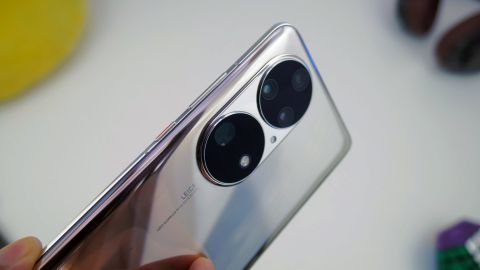TechRadar Verdict
Huawei continues to show its prowess with the Huawei P50 Pro, which is a beautiful phone that offers excellent performance and has an impressive main camera. Over the years, Huawei has managed to convince many regional developers to get on board with its Google-services-missing platform, but some of the bigger players are still absent; so if you’re very reliant on Google services then the P50 Pro might not be the phone for you.
Pros
- +
Excellent primary camera
- +
Device feels premium in the hand
- +
Fast wired and wireless charging
Cons
- -
Still no Google services
- -
No 5G capability
- -
Color accuracy from ultrawide and telephoto cameras isn’t the best
Why you can trust TechRadar
Two-minute review
Huawei doesn’t really need to keep proving that it can make flagship phones that can go head to head with handsets from any other manufacturer. We’ve seen Huawei do it repeatedly with its Mate and P series of phones, which have pushed boundaries in terms of design, features and mobile photography year after year. The Huawei P50 Pro continues in that vein.
The challenge – and you’ve heard this before – comes on the software side. Ever since the United States imposed a ban on Huawei using Google services, Huawei has been working to develop its own platform based on Android, to persuade app developers to publish their apps on its own App Gallery.
Depending on which part of the world you live in, Huawei has made decent progress in this respect, with many of the popular regional apps and services available in the App Gallery. It’s the bigger developers that Huawei needs to win over: while major apps such as Snapchat and TikTok are in the App Gallery, the likes of Instagram and WhatsApp are still missing.
Leaving the software aside, though, with the P50 Pro Huawei has once again made an impressive phone that can compete with flagships from any leading manufacturer.
The design of the P50 Pro is striking: it looks gorgeous, it’s thin and light, and it sits really nicely in your hand. It looks and feels every inch like a luxury product.
Performance is impressive thanks to the Qualcomm Snapdragon 888 processor, with apps launching quickly and running smoothly. The 8GB of RAM on offer isn’t a class-leading spec, but it’s enough to ensure that the phone feels zippy. Storage options differ across regions – our review model has 256GB, which is plenty for the average user. The phone does, however, lack 5G support, another consequence of US restrictions.
Where the Huawei P50 Pro really shines is photography, which isn’t surprising as Huawei has long been at the forefront of mobile photography, especially with its P series. The main camera on the Huawei P50 Pro is fantastic, and capable of capturing brilliant shots in any lighting conditions. We were, however, slightly disappointed with the ultrawide and telephoto cameras, which don’t offer the best color fidelity compared to the primary shooter.
The battery capacity on the Huawei P50 Pro isn’t the biggest we’ve seen, but it’s good enough to see you through a day of moderate use. Huawei offers fast 66W wired charging, and almost as fast 50W wireless charging, enabling you to top up quickly when needed.
Overall the Huawei P50 Pro has everything you’d expect of a flagship phone in 2022, and the progress that Huawei has made with getting apps on its platform is commendable. Ultimately though, which apps you use regularly, and in particular the extent to which you rely on Google services such as Gmail, Google Photos, Maps and YouTube, will dictate whether or not the P50 Pro is a phone you should be looking at.
Huawei P50 Pro release date and price
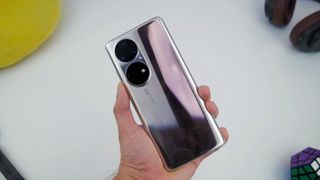
The Huawei P50 was announced for China last year, and is now being rolled out internationally. The phone is currently available in the UK, among other regions such as the UAE and Saudi Arabia.
Huawei doesn’t usually sell its phones in the US or Australia, so don’t expect to be able to buy it there.
In the UK and the UAE there’s a single configuration of the Huawei P50 Pro – 8GB of RAM and 256GB of storage – which is priced at £1,099.99 / AED3,999. Capacity-wise at least, for what you get the Huawei P50 Pro is better value than the iPhone 13 Pro Max and the Samsung Galaxy S22 Ultra.
The Huawei P50 Pro was originally announced in four colors, and availability varies by region. In the UK though it's available in Golden Black and Cocoa Gold colors.
Design and display

Huawei is no stranger to releasing good-looking and premium-feeling phones, and the P50 Pro looks sleek and stylish, and sits well in the hand. Measuring 158.8 x 72.8mm and weighing 195g, the P50 Pro is neither too big nor too heavy.
Like most Huawei flagship phones of recent years, the volume buttons and the power button sit on the right side while the USB Type-C port and the SIM tray are located at the bottom.
Speakers are located on the top and bottom while the fingerprint sensor is behind the screen, which has curved edges that wrap into the metallic frame.
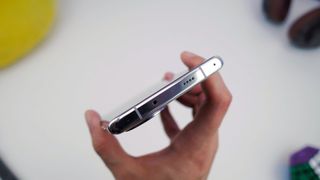
The Huawei P50 Pro is available in four colors: Golden Black, Pearl White, Charm Pink and Cocoa Gold, although which colors are available to you may depend on which part of the world you live in. We reviewed the Cocoa Gold model, which you can see pictured throughout this article.
The rear of the phone has a polished metallic surface with a subtle gold appearance. It looks slick, but it does attract fingerprints.The back of the phone is also home to two rather large camera ring modules housed inside a pill bump which doesn’t stick out as much as those on some of the recent flagship phones we’ve seen.
Nevertheless, the ‘dual matrix camera’ as Huawei likes to call it certainly stands out, and will elicit varying reactions, from intimidating to intriguing.

The screen on the Huawei P50 Pro is 6.6 inches in size with a resolution of 1228 x 2700 with a pixel density of 450ppi. For comparison the Samsung S21 Ultra comes in at 1440 x 3200 for 515ppi and the iPhone 13 Pro Max at 1284 x 2778 for 458ppi. Don’t get too wrapped up in the numbers though – all these phones have very high-resolution screens that look sharp.
Color reproduction is excellent, and the OLED screen is great for watching movies and videos on. Huawei has also increased the refresh rate to 120Hz, up from 90Hz on the P40 Pro, which makes navigating the UI or scrolling through apps super-smooth. You can set the refresh rate to Dynamic, which adjusts the refresh rate depending on what you’re doing on your phone, to save battery life, but you’ll get the smoothest all-round experience by setting it to High.
Specs and performance
The Huawei P50 Pro is powered by the Qualcomm Snapdragon 888 chipset found in most of last year’s flagship phones of last year, with one omission: it only comes with an LTE/4G connectivity.
The chipset is teamed up with 8GB of RAM and 256GB of storage on our review model, which should be sufficient storage for most people, but 128GB and 512GB versions are available in other markets, with the latter also getting a bump in RAM to 12GB.
You can also expand the storage capacity through Huawei’s Nano Memory (NM) card. While this format isn’t as popular as microSD cards, NM cards have the same shape and size as a Nano SIM card, making it easy to use a secondary SIM or a Nano Memory card on the SIM tray of Huawei phones.

Like all other flagship phones, the Huawei P50 Pro proved to be extremely smooth and zippy in day-to-day use. The phone scored 3018 in Geekbench 5, which is pretty much around what other Snapdragon 888-based phones have scored.
As to the lack of 5G, as mentioned this is down to the restrictions imposed on Huawei, and how important is 5G is something you’ll need to decide on. We ran a speed test using 4G and got a download speed of 292 Mbps on the Huawei P50 Pro.
For comparison, the iPhone 13 Pro Max in 5G mode managed a download speed of 586Mbps. So the iPhone has double the speed, and will surely download things more quickly, but to put things in perspective you only need 25Mbps to stream a 4K video.
Huawei has also gotten very good at facilitating connectivity between devices in its own ecosystem – so if you have a Huawei laptop or tablet, or a MateView monitor, these devices can easily connect with your Huawei phone, and with each other, and can share data seamlessly.
Camera
The Huawei P50 Pro is equipped with quite an intimidating pill-shaped camera bump, which is home to four AI-powered Leica cameras. The primary wide camera has a 50MP sensor, and this is teamed with a 64MP periscope telephoto lens capable of 3.5x optical zoom, a 13MP ultra-wide lens, and a 40MP monochrome sensor.
Given this hardware, it comes as no surprise that the P50 Pro can take stunning images. We were rarely left disappointed with the cameras, especially during the day. Pictures came out sharp, detailed and with a wide dynamic range.
Huawei smartphones have in the past been known to boost colors to make images look more vibrant and appealing. But with the P50 Pro, the image processing is such that colors, including those all-important skin tones, look truer to life. Moreover, the dedicated AI mode has been fine-tuned to make more subtle and targeted adjustments to pictures rather than just cranking up the vibrancy.




The P50 Pro camera setup gives you plenty of shooting options Being able to get an ultra-wide view of a scene is always useful, and so is the dedicated macro mode for close-up images. However, the color management across these modes is something Huawei still needs to work on. For instance, a picture taken using the primary wide lens will look warmer than the same picture taken with the ultra-wide lens. Given that this is a flagship experience, we’re a bit disappointed by such color shifts.
This is also noticeable when switching between from the primary wide lens to the periscope telephoto lens where you find a 3.5x optical zoom with a level of detail that is incredible. You can zoom up to 100x with the P50 Pro, and for the most part images up until 30-50x zoom are somewhat usable with the rest of the zoom range being a novelty factor. It’s a similar story with the dedicated monochrome sensor. For photography novices, this just seems like applying a B/W filter over any regular image, and for the most part, it is. However, photography buffs may be able to appreciate this feature more.




As enjoyable as day-time photography on the P50 Pro is, there are a few caveats. First, the camera’s shutter speed is on the slower side, and we often found ourselves waiting a split-second before a photo was taken. In most situations this won’t be a big deal, but if you ever find yourself trying to capture a fleeting moment you could potentially miss the shot.
Second, the camera’s viewfinder does not depict accurately what a picture will look like once captured. When we were taking pictures that included the sky, the viewfinder showed images to be overexposed and blown out. However, once the picture is taken, the smartphone’s processing kicks in to produce a well-exposed shot. This isn’t a criticism of the image quality, it’s just something that we’d note is part of the user experience.
When it comes to low-light photography, Huawei has always been at the forefront. However, while low-light images from the P50 Pro do look impressive, they’re not as sharp as we’ve seen from some competitors recently. Certain low-light images, especially of buildings, often have a slight softness to them.
And oddly, enabling night mode made things worse, as the longer exposure introduced blur into photos, even though in most cases the night mode timer was only one second. We also encountered some glitches where the timer stayed on for 10-12 seconds, with the resulting photo being a blurry mess. We hope that these are anomalies that can be ironed out with software updates.






Low-light results from using the ultra-wide camera are relatively disappointing. Modern day flagships employ a setup where both the primary and the ultra-wide lens are of similar calibre. But in the case of the P50 Pro, the lower-resolution sensor, combined with the inconsistencies in color we’ve mentioned, make for a less-than-ideal low-light experience. Even when you want to use the ultra-wide lens for a 0.8x or 0.9x zoomed-out view, the resulting quality loss is quite noticeable. You can make up for it to a certain extent by using night-mode; however this leads to purple fringing in the resulting image.
When it comes to video capture, the P50 Pro can record up to 4K video at 60fps. Both the primary wide lens and the periscope telephoto lens have optical image stabilization, (OIS) but there is no such assistance for the ultra-wide lens. Moreover, the ultra-wide lens is capped at 4K 30fps. If you’re smooth with your movements and don’t switch lenses mid-recording, the video experience from the P50 Pro camera is good. But when you want to use multiple lenses, the transitions are jagged and rough.
On the front, the P50 Pro sports a single 13MP selfie snapper. Its quality is adequate for most situations and for social media posting, thanks in large part to its wider field of view. You can also take advantage of night mode in low light, although images come out a little softer than we’d like. As with the primary camera, the selfie camera also supports an array of portrait mode options, although while these work well when it comes to edge detection for background blur effects, the camera does have the tendency to beautify your face a bit much, even when beauty mode is toggled off.



Software
As is the case with all Huawei phones of late, the P50 Pro runs Android but without Google services due to restrictions imposed by the US government. Interestingly, Huawei has chosen to release the P50 Pro in international markets with EMUI which is more of a skin on Android 10 rather than HarmonyOS - a fork on Android, which is what’s being used in China.
The lack of Google services and the Play Store is something users will need to reckon with, and depending on where in the world you live, and how heavily you depend on Google services, it could be anywhere between a minor annoyance and a reason to not even consider this phone.
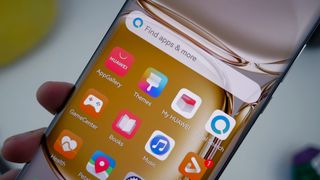
Huawei has put a lot of effort getting app developers to port their apps to App Gallery, which is Huawei’s equivalent of the Play Store, and again, depending on the region, your mileage may vary. In the Middle East, many of the most popular apps – from banking to food delivery and utility services – have been available on App Gallery. But support for some of the larger apps, like Instagram and WhatsApp, is still missing. While there are ways of getting around that by sideloading such apps – and Huawei makes it easy to do so, getting Google apps onto your Huawei phone is seemingly impossible.
If you rely on Gmail or Google Photos or YouTube, for example, your only option is to access these services using a web browser which isn’t an ideal experience. It’s a frustrating situation, and something that’s beyond Huawei’s control, which is a shame as the phone’s UI looks great and is smooth to use.
With EMUI 12, which is built upon Android 10, Huawei has polished the UI to look beautiful. The icons have been redesigned and the fonts look good. Interface tweaks such as large folders on the home screen or widget access via long-pressing an app icon help with everyday usability.
Battery life
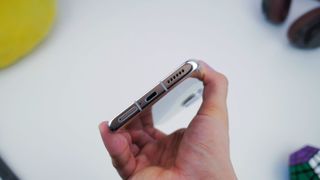
The P50 Pro is powered by a 4,360mAh battery, which is somewhat on the small side considering the phone’s 8.5mm thickness. However, with the phone not supporting 5G, the battery capacity and endurance are adequate for a full day of moderate use.
This translates to around 6-7 hours of screen-on time before you need to juice up your phone. If you’re a heavy user who’s constantly online, using the GPS and taking pictures and videos, screen-on time may dip below six hours, and a recharge might be necessary before the end of the day.
Thankfully, Huawei has a suite of in-built charging features that mean you should be able to avoid battery-life issues. For one, its 66W charging speed via the included brick means you’ll be able to go from 0-70% in about 30 minutes, with a full charge possible in just under an hour.
More impressively, the P50 Pro also supports 50W wireless charging with the optional proprietary charger. If you’re used to placing your smartphone on a wireless pad when working, you’re unlikely to run out of charge at important moments. Unfortunately, there’s no support for reverse wireless charging on the flagship, which is surprising as we’ve seen this on previous Huawei phones.
Should you buy the Huawei P50 Pro?

Buy it if...
You’re looking for an excellent camera phone
The Huawei P series stands out for its cameras, and the P50 Pro is no different. The primary camera takes excellent shots at any time of the day..
You’re happy with a Google-free flagship Android phone
If you’re looking for an Android phone but don’t use any of Google’s services, the P50 Pro is one of the best phones you can buy.
You own other Huawei devices and want seamless
Huawei has done an excellent job of integrating its devices within its ecosystem. If you already own a Huawei laptop, tablet or monitor, the P50 Pro can seamlessly exchange data or share screens with them.
Don’t buy it if...
Google services are important to you
If Google services such as Gmail, Google Photos, YouTube and Google Maps are essential to your life or work then you’re better off looking elsewhere.
You need to have 5G connectivity
The Huawei P50 Pro doesn’t come with a 5G connectivity, and if you want next-gen connectivity on your next phone then you’ll have to look at alternatives.
You’re looking for an affordable phone
The Huawei P50 Pro is a flagship phone with a flagship price tag, even if it is more affordable than rivals from Apple and Samsung.
First reviewed: January 2022

Abbas has been living and breathing tech before phones became smart or clouds started storing data. It all started when he got his very first computer- the Sinclair ZX Spectrum. From computers to mobile phones and watches, Abbas is always interested in tech that is smarter and smaller because he believes that tech shouldn’t be something that gets added to your life- it should be a part of your life.
